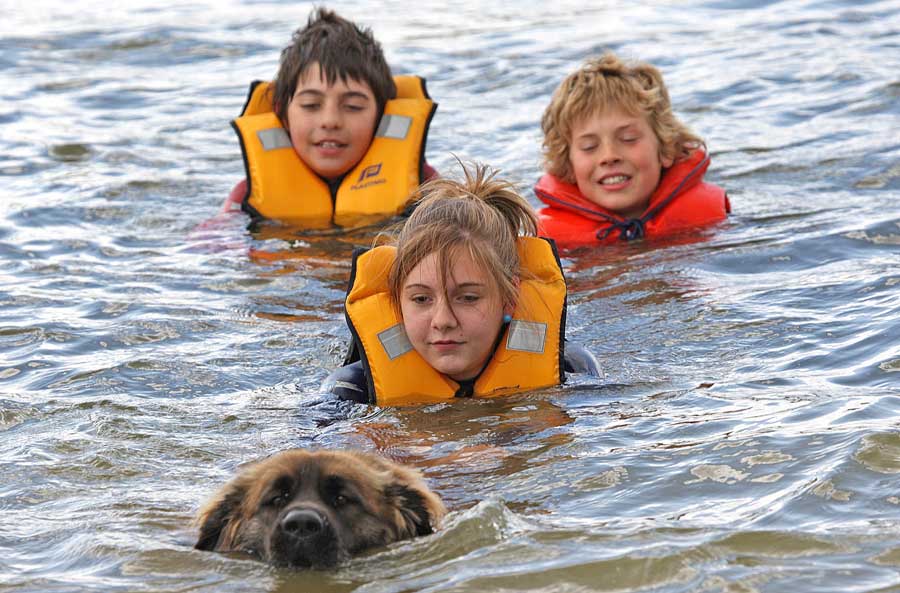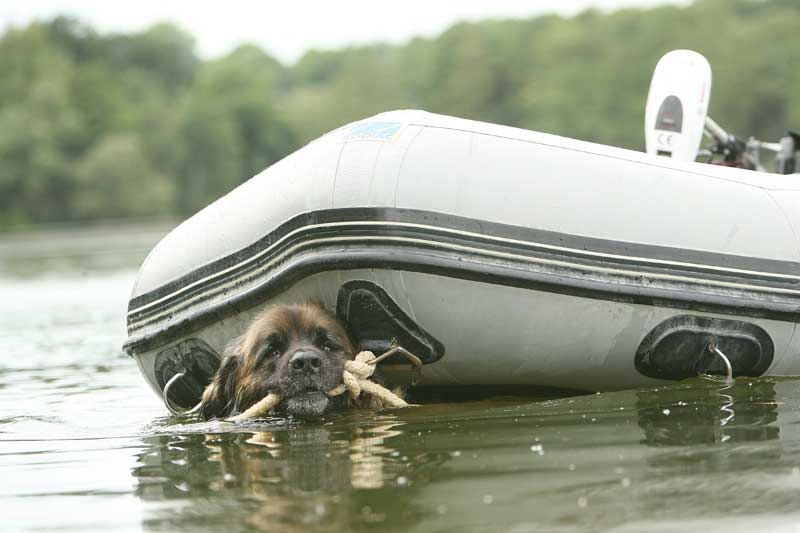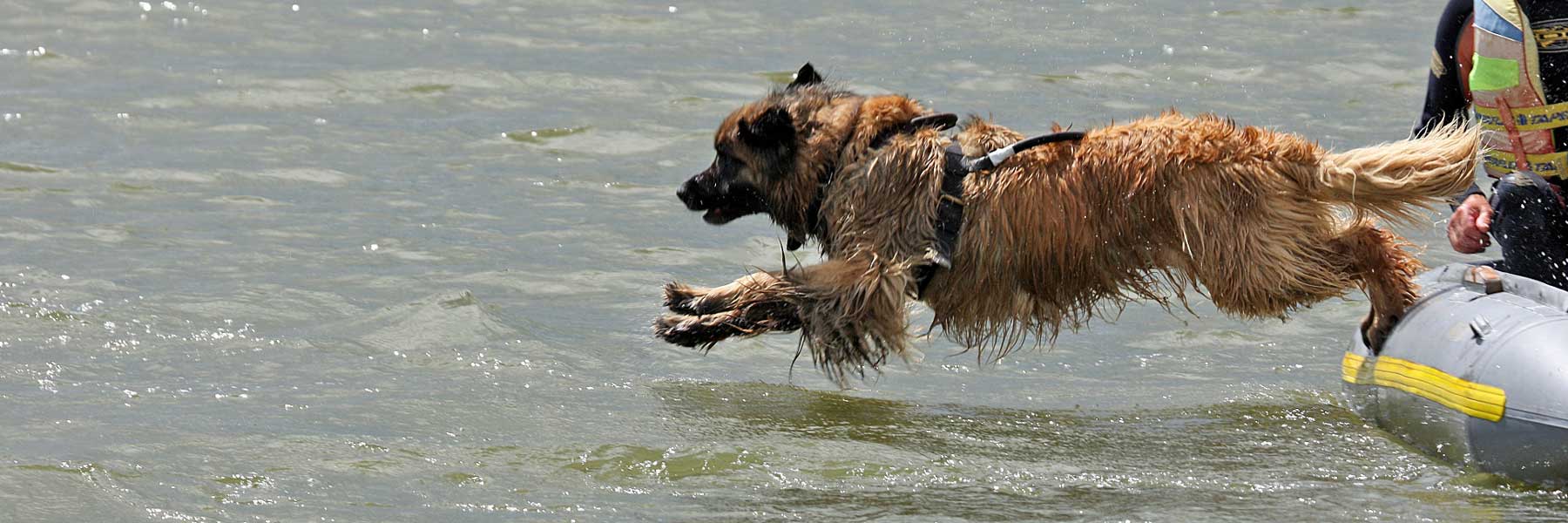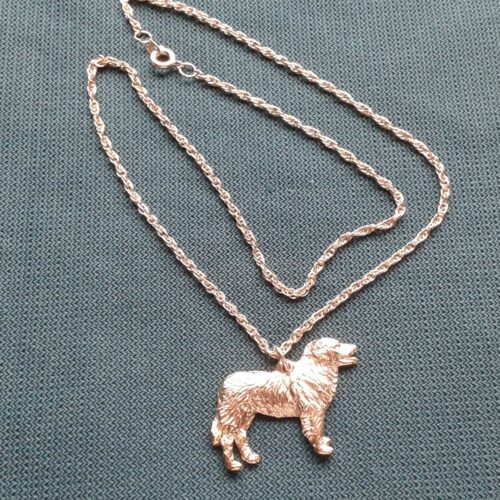Water Work
A Leonberger that does not enjoy the water is certainly the exception to the rule, so if you want to channel this enthusiasm for all things wet into something constructive, then water training may be for you.
With the aid of several experienced and dedicated members The LCGB Working Section organise several Water Training Groups around the Country;
- Suffolk Norfolk border you will find the Waveney Water Lions,
- Cambridgeshire you will find the Hinchingbrook Working Leos,
- Wiltshire you have Wiltshire Wet Leos,
- Sale Nr. Manchester you will find the North West Wet Leos.
Contact details for all of these groups and their training dates can be found on their websites.
People choose to come water training for many reasons, some have no great ambitions and just want the social aspect of the groups, and enjoy their dogs having great fun in the water. There is nothing nicer than a day by the lake, maybe a picnic whilst you watch other Leos work, in between helping out in the water and training your own dog. The more ambitious members will enjoy training for our tests and relish our test days. All of our groups will welcome all types of members.

To begin with you will be able to borrow the necessary dog harness and a wetsuit and lifejacket, from your group, only committing to purchasing your own equipment slowly over time if you are sure that swimming with your Leo is really for you.
The joy of our working tests is that they work on the Pass and Fail system, the only team that you compete with is your own!! Twenty teams can enter, and twenty can pass all with equal merit, no one team happier than any other, one advantage over the showing and obedience world, where often only one person is truly happy in each class.
You will find that you can be involved all day at your training clubs, people are need to fall over board, swim out to be rescued etc. and the more different people a dog works with over its training the better, so as a strange face at your training club you will be popular with those working at higher levels who need a stranger to practice with
For those interested in training for tests there are five different test Sections A – E, all the tests work on the building block system, so I always encourage people to read all the tests, if you know what you will have to do in Section E the highest level, and start training for Section A with this information in mind it will make your progress through the levels much smoother. For example in the lower levels your dog is allowed to go and rescue his owner but once you get to section C all the people he has to go to are strangers. If you know this, at the very start you can start sending your puppy to trusted and experienced strangers from the very beginning, so swimming out away from you will become second nature. In Section D your dog will have to start carrying items out to a boat, in A, B & C all the people and articles are brought back to you. If you know your dog will be required to carry things out later, you can introduce this early on in your training and play.

Basic Skills
The basic skills you will teach your dog to enable him to enjoy his self in the water with you and to pass the tests are as follows:
He will need to learn that whilst he can swim with and around people he must never climb on or paw at people in the water, any climbing must be calmly and quietly discouraged teaching the dog to swim around people near enough to be touched but not climbing or pawing, this will keep both you and him safe in the water.
He will need to learn to fetch people and articles from the water from varying distances up to 30m away at the higher levels. Look through the regulations and see which articles are used and practice with all of them, starting with the easiest and working up to the paddle or oar, before you enter a test your dog should be happy with any of the articles he may meet in that particular test.
He will need to learn to do a directed retrieve i.e. when faced with two articles or swimmers out in the water you will need to be able to send him to either the left or right article ignoring the other one.
He will need to learn to swim safely beside you within 2m of your head but not so close as to climb on you or interfere with your swimming stroke, he will need to swim at your pace and turn left and right with you when directed, a bit like heel work in the water. Like heel work we start this in water just deep enough to enable the dog to swim but shallow enough for us to walk so we can guide and correct them, once this is working well then and only then can you start to swim yourself.
He will also need to learn pick a rope up from under 20cm of water and return it to you, this catches some out but if you start slowly in 2-3 cm of water and gradually go deeper until your dog is confident to submerge his whole face.
He will need to ride quietly in the inflatable boat and eventually he will have to learn to jump out of the boat either to tow it back to shore, or to rescue someone who has fallen over board, or at the very highest level to take a tow rope to a stranger in another inflatable that is “drifting” away
All of this is learnt one baby step at a time with safety first and fun a very close second.
A copy of the Water Test Regulations, available to download, is linked in the bottom of this page.
We hope that this has tempted you to dip a paw in the water please contact your nearest Water group and they will steer you in right direction.


